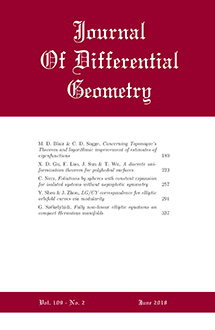Abstract
The nonlocal $s$-fractional minimal surface equation for $\Sigma = \partial E$ where $E$ is an open set in $\mathbb{R}^N$ is given by
\[ H_\Sigma^ s (p) := \int_{\mathbb{R}^N} \frac{\chi_E(x) - \chi_{E^c}(x)} {{\lvert x-p \rvert}^{N+s}}\, dx \ =\ 0 \; \textrm{for all} \; p\in\Sigma \textrm{ .} \]
Here $0 \lt s \lt 1 , \chi$ designates characteristic function, and the integral is understood in the principal value sense. The classical notion of minimal surface is recovered by letting $s \to 1$. In this paper we exhibit the first concrete examples (beyond the plane) of nonlocal $s$-minimal surfaces. When $s$ is close to $1$, we first construct a connected embedded $s$-minimal surface of revolution in $\mathbb{R}^3$, the nonlocal catenoid, an analog of the standard catenoid $\lvert x_3 \rvert = \log(r+ \sqrt{r^2 - 1})$. Rather than eventual logarithmic growth, this surface becomes asymptotic to the cone $\lvert x_3 \rvert = r \sqrt{1 - s}$. We also find a two-sheet embedded s-minimal surface asymptotic to the same cone, an analog to the simple union of two parallel planes.
On the other hand, for any $0 \lt s \lt 1 , n , m \geq 1$, $s$-minimal Lawson cones $\lvert v \rvert = \alpha \lvert u \rvert, (u, v) \in \mathbb{R}^n \times \mathbb{R}^m$, are found to exist. In sharp contrast with the classical case, we prove their stability for small $s$ and $n + m = 7$, which suggests that unlike the classical theory (or the case $s$ close to $1$), the regularity of $s$-area minimizing surfaces may not hold true in dimension $7$.
Citation
Juan Dávila. Manuel del Pino. Juncheng Wei. "Nonlocal $s$-minimal surfaces and Lawson cones." J. Differential Geom. 109 (1) 111 - 175, May 2018. https://doi.org/10.4310/jdg/1525399218





